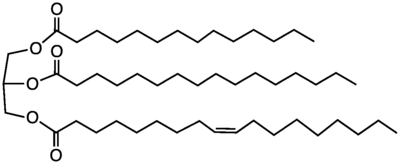Butterfat
Butterfat or milkfat is the fatty portion of milk. Milk and cream are often sold according to the amount of butterfat they contain.
Composition
The fatty acids of butterfat are typically composed as follows (by mass fraction):[1][2]

Fatty acids v triglycerides
As shown above, the composition of fats in milk is usually discussed in terms of the fatty acids. Fatty acids do not occur as such in milk (and rarely in any food). Instead, they are incorporated into compounds called triglycerides.[2]
U.S. standards
In the U.S., there are federal standards[3] for butterfat content of dairy products.[4][5][6][7] Many other countries also have standards for minimum fat levels in dairy products. Commercial products generally contain the minimum legal amount of fat with any excess being removed to make cream, a valuable commodity.
- Milks
- Skim milk contains less than 0.5% fat, typically 0.1%
- Lowfat milk contains between 0.5–2% fat; 1% and 2% varieties are widely marketed
- Whole milk contains at least 3.25% fat
- Cheeses
- Dry curd and nonfat cottage cheese contain less than 0.5% fat
- Lowfat cottage cheese contains 0.5–2% fat
- Cottage cheese contains at least 4% fat
- Swiss cheese contains at least 43% fat relative to the total solids
- Cheddar cheese contains at least 50% fat relative to the total solids
- Frozen desserts
- sherbet contains 1–2% fat
- Lowfat ice cream, also called ice milk, contains no more than 2.6% fat
- Ice cream contains at least 10% fat
- Frozen custard, like ice cream, contains at least 10% fat, but it also must contain at least 1.4% egg yolk solids
- Creams
- Half and half contains 10.5–18% fat
- Light cream and sour cream contain 18–30% fat
- Light whipping cream (often called simply "whipping cream") contains 30–36% fat
- Heavy cream contains a minimum of 36% fat
- Manufacturer's cream (not federally regulated) contains 40% fat
- Butter (including whipped butter) contains at least 80% fat
See also
References
- ↑ National Research Council, 1976, online edition Fat Content and Composition of Animal Products, Printing and Publishing Office, National Academy of Science, Washington, D.C., ISBN 0-309-02440-4; p. 203
- 1 2 The quote values vary by 1-3% according to the source: Rolf Jost "Milk and Dairy Products" Ullmann's Encyclopedia of Industrial Chemistry, Wiley-VCH, Weinheim, 2002. doi:10.1002/14356007.a16_589.pub3
- ↑ United States Department of Agriculture Agricultural Marketing Service
- ↑ USDA Commercial Item Description: Milks, Fluid (2001).
- ↑ USDA Specifications for Cream Cheese, Cream Cheese with other Foods, and Related Products (1994).
- ↑ United States Department of Agriculture Standard for Ice Cream (1977).
- ↑ USDA Commercial Item Description: Cream, Eggnog, Half-and-half, and Sour Cream (2002).